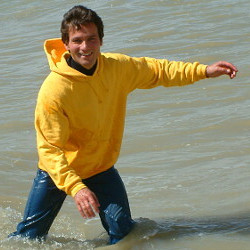Open Water Swimming Kit
Survival swimming clothes protect you in open water and on the beach against rocks, pebbles, sunburn and wind chill. Wear at least the outer layer, just to be safe.
We wear full gear for realistic training and and fitness unless otherwise instructed. "Full Gear" means two long sleeve tops, trousers, socks and boots, and a helmet where required.
Be Visible
Bright coloured swimming clothes and a hat or hood can be seen by fast moving traffic. Lifeguard uniforms are easy to swim in as they are designed to be worn for water rescues.
Swim with whatever clothes you feel comfortable in. Just make sure they fit well and don't interfere with your swimming ability. Gain experience by swimming in different types of clothes like tee-shirt, sweatshirt, trousers or jeans, anorak or windproof rain suit.
Waterproof clothes are the most practical outfit as they dry quickly,
don't weigh much and protect you from wind chill.
Depending on their design they hold more or less water when swimming.
You can find all sorts of robust and inexpensive training gear in army surplus stores.
Full Survival Gear
Swimmers should bring three unlined clothing layers (base, middle, outer), as used in canoeing, coasteering, sailing or other adventure sports. High visibility clothes would be an advantage.
This will get wet:
- T-shirts (long and short sleeves)
- Hoodie, sweatshirt or pullover
- Trousers, cargo pants or jeans
- Anorak and rain pants, or coverall
- Trainers or sports shoes and socks
- Poncho as shelter and changing room
- Sleeping mat as float and for sitting on
Some swimmers like to wear boots or socks, neoprene balaclava hats and wet suits,
especially in colder weather if they want to spend more time in the water.
Always start a session in dry kit.
If you plan several swimming sessions, you need need a bit more gear
as it is not nice to put on clammy cold clothes after a warm-up break.
Remember to bring a change of dry clothes for your way home.


Dry Bag for Water Trekking
Some rucksacks are completly waterproof, but you could use an old rucksack with drain holes that keep the water from filling it up.
Everything that must stay dry goes inside robust waterproof bags, but no more than that. They provide the buoyancy which lets you use it as a flotation device.
- Dry clothes and shoes to change into afterwards
- Sleeping bag and mat (mission-dependent)
- Plenty to eat and drink
- A large beach towel